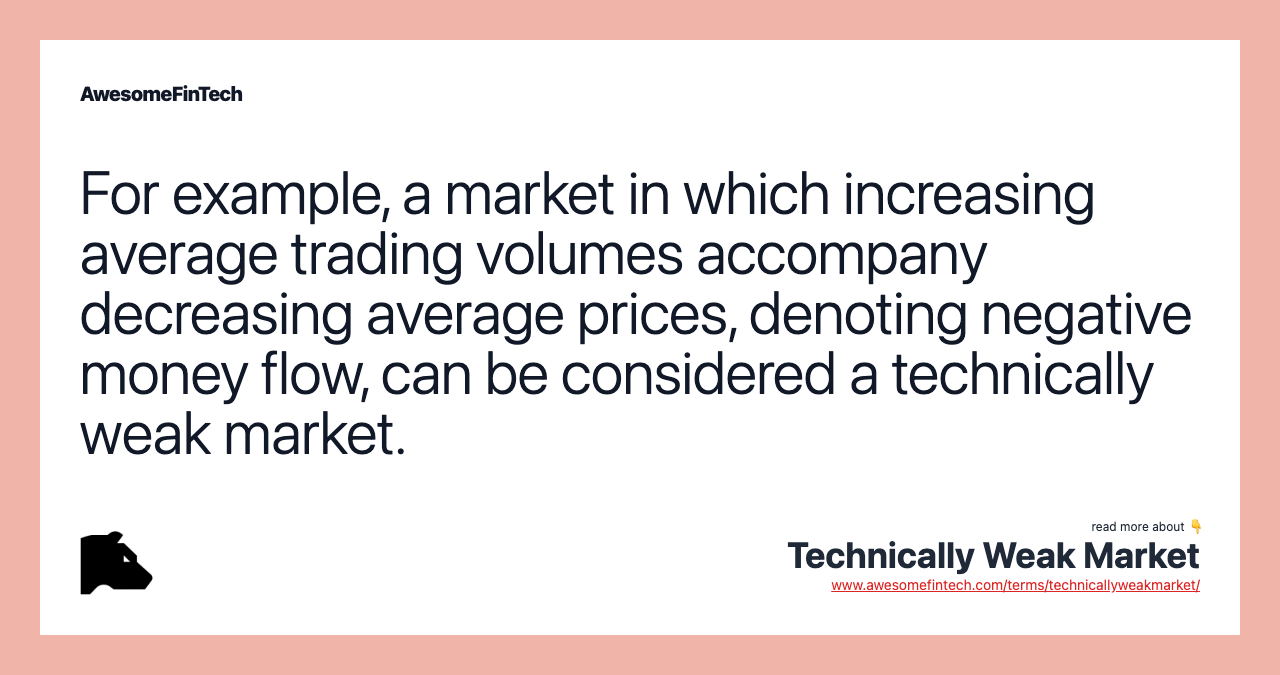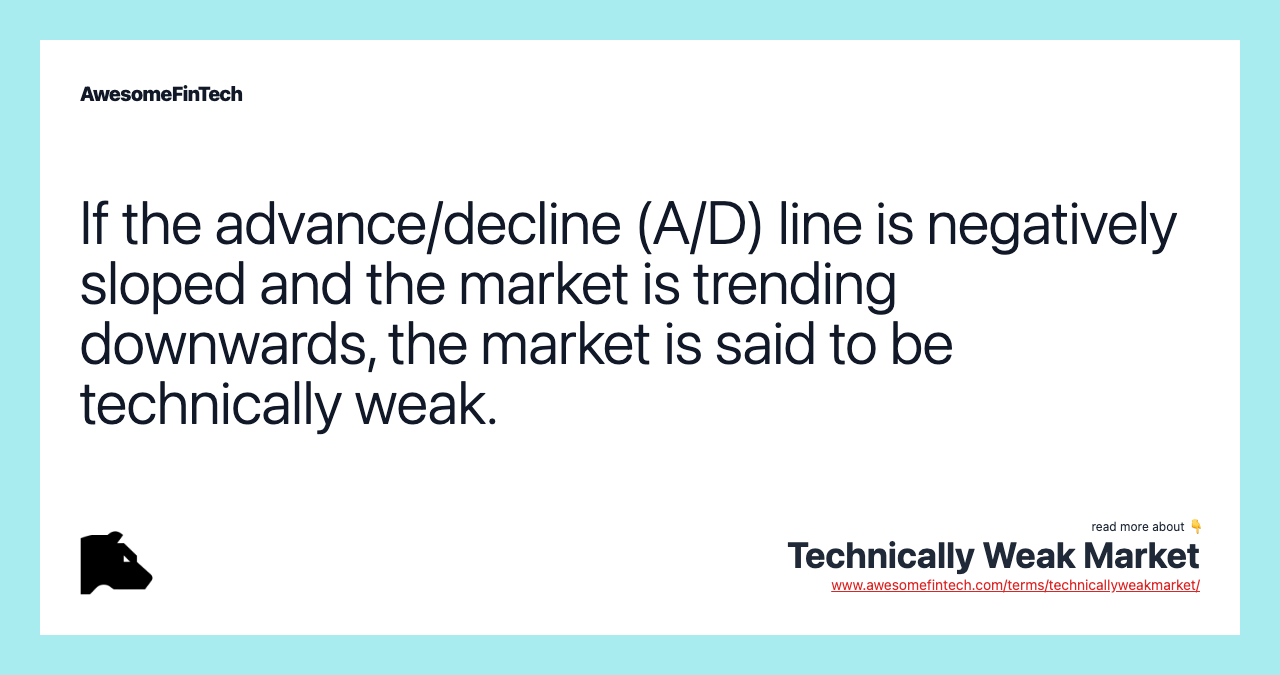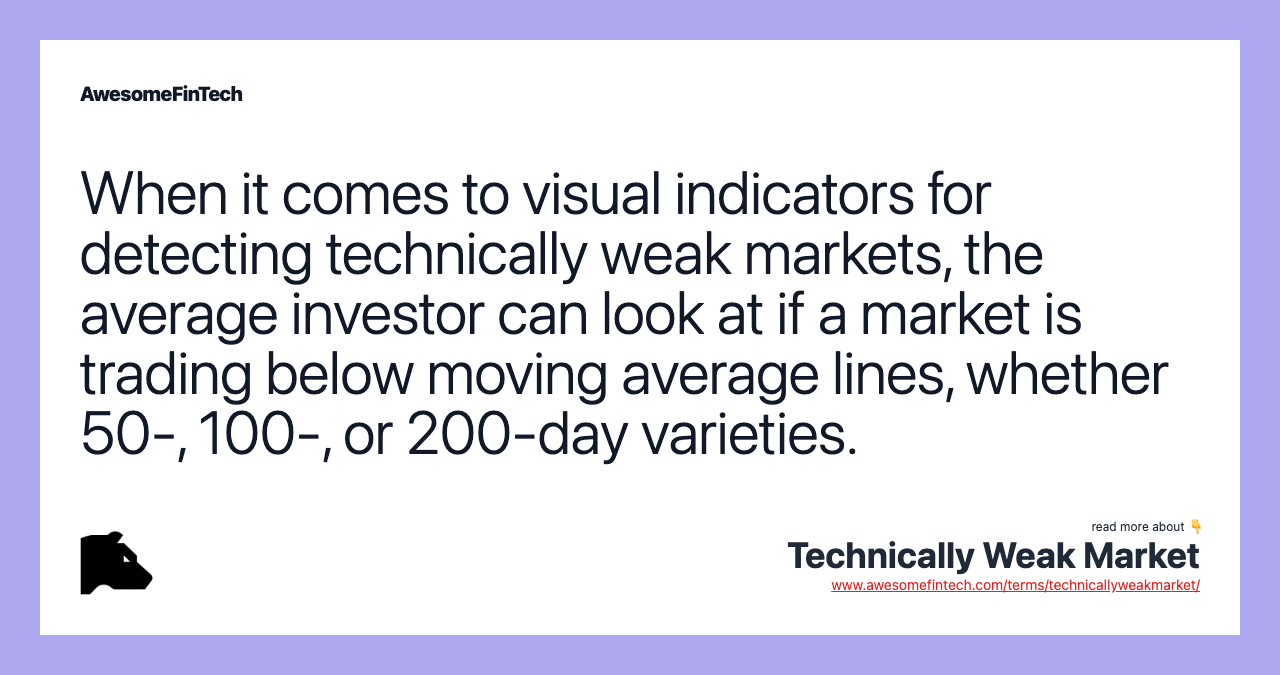Technically Weak Market
A technically weak market reflects the fragile signals or negative data points from money flow or technical analysis that contribute to the overall fragility of the market. For example, a market in which increasing average trading volumes accompany decreasing average prices, denoting negative money flow, can be considered a technically weak market. For example, a market in which increasing average trading volumes accompany decreasing average prices, denoting negative money flow, can be considered a technically weak market. The opposite of a technically weak market is a technically strong market, which looks at similar indicators as the ones discussed such as advance/decline lines, the Arms Index, and moving averages. When it comes to visual indicators for detecting technically weak markets, the average investor can look at if a market is trading below moving average lines, whether 50-, 100-, or 200-day varieties.

What Is a Technically Weak Market?
A technically weak market reflects the fragile signals or negative data points from money flow or technical analysis that contribute to the overall fragility of the market. Common indicators that can show whether a technically weak market exists include looking at advance/decline line (A/D), Arms Index (TRIN), and moving averages.
Typically, technically weak markets are considered to be bearish markets, in which the market shows declining trading volume and prices.




How Technically Weak Markets Work
For example, a market in which increasing average trading volumes accompany decreasing average prices, denoting negative money flow, can be considered a technically weak market. In technically weak markets, bearish activity in the market in which prices continue to decline can be expected to continue.
In the same vein, when decreasing average trading volumes occur with increasing average prices, there is an indication that buying conviction is fading. In contrast, higher prices with higher trading volume signal a bullish, strong market.
The advance/decline line is a popular tool for gauging overall market internals. If the A/D line is negatively sloped and the market is trending downward, the market is said to be technically weak. A related measure of market breadth, which shows the extent of participation of stocks in market rises, is the Arms Index. Based on the way that the Arms Index is calculated, a value of greater than 1.0 is indicative of flagging market activity.
When it comes to visual indicators for detecting technically weak markets, the average investor can also look at moving average lines, whether of the 50-, 100-, or 200-day varieties. The average investor can see where a current market line is relative to the moving average lines. At a glance, a market that is trading below these lines is considered to be in a weak technical state.
Technical analysts try to profit from trends in the prices of securities. They believe that historical pricing trends tend to repeat themselves, and by using price charts to identify these trends they can determine the best times to buy or sell to make a profit. When they spot a technically weak market for a security, a basket of securities, or a broad index, they can express their bearishness in short positions.
The opposite of a technically weak market is a technically strong market, which looks at similar indicators as the ones discussed such as advance/decline lines, the Arms Index, and moving averages.
Related terms:
Advance/Decline Index and Uses
The Advance/Decline Index is a market breadth indicator representing the difference between the number of advancing and declining securities within an index. It is used to determine overall market weakness or strength. read more
Advance/Decline Line - A/D and Uses
The Advance/Decline Line (A/D) is a technical indicator that shows the number of advancing stock less the number of declining stocks. It is a breadth indicator used to show market sentiment. read more
Arms Index (TRIN) and Application
The Arms Index or Short-Term Trading Index, also called TRIN, is a technical analysis breadth indicator that measures the number of advancing and declining stocks and volume to provide overbought and oversold levels. read more
Bear Market : Phases & Examples
A bear market occurs when prices in the market fall by 20% or more. read more
Breadth of Market Theory
The breadth of market theory is a technical analysis method for gauging market direction and strength. read more
Downtrend
A downtrend refers to the price action of a security that moves lower in price as it fluctuates over time. read more
Market Breadth
Market breadth is a technical analysis technique that gauges the strength or weakness of moves in a major index. read more
Technical Analysis of Stocks and Trends
Technical analysis of stocks and trends is the study of historical market data, including price and volume, to predict future market behavior. read more
Technically Strong Market
A technically strong market reflects favorable indicators on a number of key statistics tracked by stock and market analysts. read more
Trending Market
A trending market is when a price series continually closes either higher or lower over a number of periods. read more